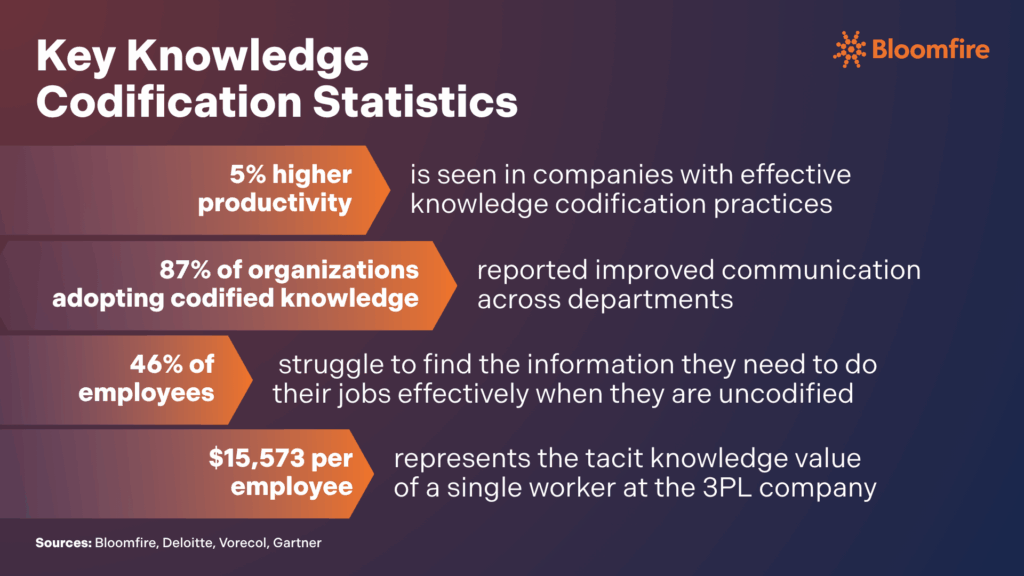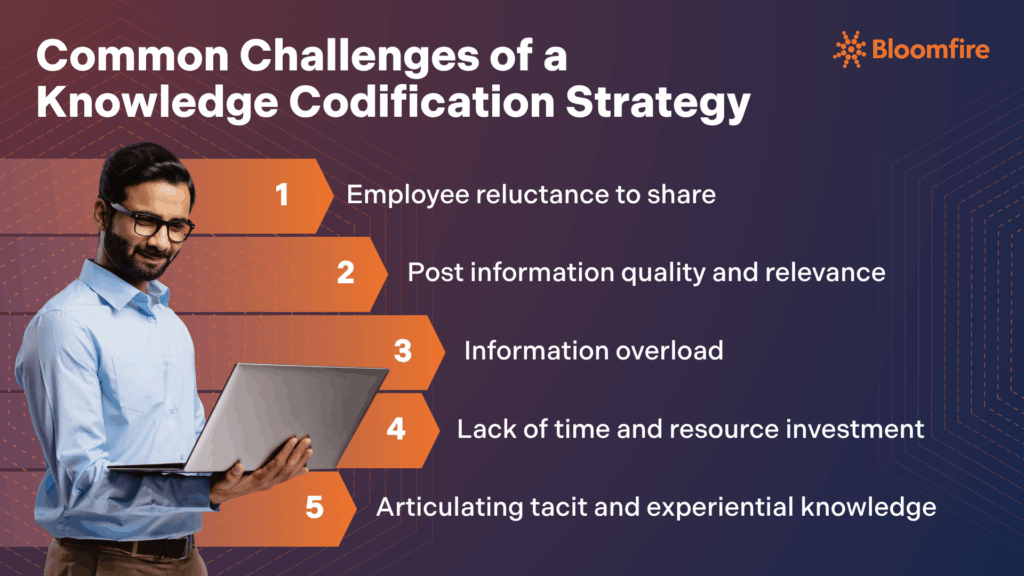Developing a Codification Strategy in Knowledge Management: A Comprehensive Guide

Strategic knowledge management (KM) is a cornerstone of competitive advantage in today’s business environment. Codification in knowledge management, a method of organizing and systematizing information for easy access, has become increasingly crucial for companies across various sectors. This process transforms tacit, often siloed knowledge into explicit, documented resources readily available to all employees.
Implementing a codification strategy in knowledge management benefits industries, such as business services, manufacturing, and finance. These sectors face the dual challenge of managing vast amounts of complex information while ensuring that knowledge is accessible and actionable.
Learn how developing a codification strategy enhances operational efficiency and positions businesses for sustained growth in an increasingly competitive landscape.
What Is Knowledge Codification?
Knowledge codification is the systematic process of capturing, organizing, and storing knowledge in a format that can be easily accessed and used by others. It’s about converting tacit knowledge—personal, context-specific insights and experiences—into explicit knowledge that is documented and shared.
The accelerated pace of digital transformation and the rapid evolution of the workforce make knowledge codification even more imperative than it already is. Knowledge codification is a key component in a KM strategy that positively influences knowledge utilization and organizational sustainability.
Possession of tacit knowledge isn’t enough. An organization must formalize and standardize it to reliably apply it and sustain operations. However, it’s essential to note that embracing a codification strategy in knowledge management is more than just organizing information; it is a comprehensive approach to managing knowledge. It represents a strategic investment in an organization’s Enterprise Intelligence, resilience, and operational excellence.
What Are the Benefits of Codification in Knowledge Management?
At a broader level, adopting a knowledge codification strategy enables companies to cultivate a more agile, informed, and productive working environment. It also paves the way for sustained growth and a distinct competitive advantage in their field. Specifically, knowledge codification provides the primary advantages:

1. Improved information accessibility
Codified knowledge becomes readily available and easily retrievable for all employees. This reduces the time individuals spend searching for essential data or expertise. Thus, it streamlines workflows and enables faster, more informed decision-making.
The necessity for a codification strategy in knowledge management has been significantly amplified by the rise of Generative AI, a point reinforced by McKinsey’s recent analysis of the artificial intelligence (AI)-centric imperative in 2025. It states that a major source of value creation is shifting from software features to proprietary data access and control. This trend requires an extensive, high-quality, and highly structured knowledge base to train AI agents effectively.
In this new paradigm, uncodified, tacit knowledge is inaccessible to these powerful systems, and poor codification can lead to AI hallucinations or the spread of inaccurate information. The shift makes formal organization of knowledge a critical precondition for successfully leveraging AI for competitive advantage.
2. Standardization of knowledge across the organization
As knowledge codification strategy ensures everyone has access to the same validated information, it helps maintain consistency in processes, practices, and service delivery. Organizations can uphold quality standards, minimize errors, and ensure alignment in common procedures and organizational goals.
An organization must formalize and standardize knowledge to reliably apply it and sustain operations. A confluence of factors drives the current urgency:
- The need for rapid upskilling to keep pace with technologies like AI and Industry 4.0
- The necessity for instant, reliable information access in increasingly remote and distributed work environments.
Without robust knowledge codification, organizations risk critical knowledge walking out the door with departing employees. It leads to inconsistent decision-making across disparate teams, and massive efficiency drains as employees waste time searching for undocumented ‘know-how.’ Therefore, transforming individual tacit knowledge into a shared, explicit, and easily retrievable corporate asset is a fundamental strategic requirement for modern business resilience.
3. Enhanced knowledge retention and transfer
Organizations can effectively prevent the loss of valuable institutional knowledge even when employees depart or transition to new roles. By leveraging documented critical insights, best practices, and operational expertise, employees gain the support they need to enhance their performance.
Codifying the tacit expertise of high-value employees transforms vulnerable individual knowledge into a resilient, non-rival organizational asset. In turn, it dramatically mitigates the financial and operational risks associated with a transient modern workforce.
4. Streamlined employee onboarding and operational scalability
Employee voluntary turnover alone costs U.S. employers almost a trillion dollars annually, with a conservative estimate that replacing a single departing employee costs 33.3% of their base salary. This staggering financial toll is largely compounded by the loss of the irreplaceable, uncodified tacit knowledge and skills the departing workers take with them.
When organizations proactively codify this expertise into explicit, reusable formats, they mitigate the financial and operational fallout from continuous churn. Additionally, with institutional knowledge preserved, onboarding new employees becomes more efficient, requiring fewer individual mentors.
A knowledge base also provides a solid foundation for scaling operations, as successful systems and proven solutions can be replicated with greater reliability and consistency. Effective codification, alongside knowledge utilization, fully mediates the relationship between overall knowledge management and improved organizational performance.
5. Enhanced organizational efficiency
A centralized, codified repository replaces the inefficient process of locating specific experts, sifting through endless emails, or recreating solutions that have already been solved. The conversion of tacit, scattered knowledge into an easily searchable and reusable asset naturally streamlines workflows and enables faster, more consistent performance across all teams.
Documenting the definitive, most efficient procedures for common tasks minimizes errors and ensures consistent quality decision-making across the organization. Essentially, a codification strategy in knowledge management acts as the blueprint for an organization’s Enterprise Intelligence.
6. Stronger foundation for innovation and continuous improvement
Management expert and McKinsey partner Michael Chui emphasized the profound impact of codified knowledge. He noted that one of the five big innovations driving the next wave of business impact is the shift towards enhanced intelligence and reasoning capabilities through AI, which fundamentally relies on a structured, explicit knowledge base.
When existing knowledge, solutions, and operational procedures are well-codified, they provide a clear and transparent baseline. You can identify areas for enhancement, build upon existing successes, and contribute to a culture of innovation and continuous improvement. This eliminates the need to reinvent the wheel.
7. Guaranteed compliance and risk management
There is an increase of over 80% in observations related to advice documentation issues within a year, underscoring the growing regulatory focus on explicit, verifiable records. This data point illustrates the rising corporate risk from poorly documented or inaccessible knowledge. Codification directly addresses such issues. Instead of relying on a single expert’s memory, the organization can prove its adherence to standards using a robust, easily searchable knowledge base.
When knowledge is codified, operational procedures, especially those related to safety, finance, and legal requirements, are clearly documented, version-controlled, and accessible to everyone who needs them. This standardization minimizes variability in how tasks are performed, thereby reducing the risk of human error and inadvertent noncompliance with industry or government regulations.
Knowledge Codification in The Digital Age: What Data Tells Us

The digital age has escalated the importance of codification, transforming it from a strategic advantage to a necessity. As organizations grow, capturing, storing, and retrieving knowledge becomes more daunting. However, evidence continues to confirm the practical advantages of knowledge codification.
A study by Deloitte found that companies with effective knowledge management practices see a 5% higher productivity than those without, demonstrating the tangible impact of codification on operational efficiency. The endeavor to codify knowledge, especially tacit knowledge, is fraught with challenges.
A survey by the American Productivity & Quality Center found that 87% of organizations adopting KMS (which relies on codified knowledge) reported improved communication across departments. It resulted in a 50% faster decision-making process.
Additionally, a 2023 Gartner report found that 46% of employees struggle to find the information they need to do their jobs effectively, highlighting a direct problem that knowledge codification can address. Moreover, our Value of Enterprise Intelligence report shows that the tacit knowledge value of a single employee at the 3PL company is $15,573. For 575 employees, the value of their collective knowledge is $8.9 million.
The implication is clear: effective codification requires a balanced approach that honors the intrinsic value of tacit knowledge while leveraging the organizational benefits of explicit documentation.
Key Components of a Successful Codification Strategy
Several key components must be considered to ensure the effectiveness of your codification strategy in knowledge management. These include identifying the knowledge to be codified, selecting appropriate tools and technologies, and establishing clear protocols for maintaining and updating the codified knowledge.
- Identification of knowledge: Determine which areas are critical to your organization’s success. Focus on capturing information that is valuable, reusable, and relevant to your team’s objectives.
- Selection of tools and technologies: Choose tools and platforms that facilitate the easy documentation, storage, and retrieval of knowledge. Use knowledge management systems, databases, or cloud-based solutions to ensure accessibility and scalability.
- Establishing protocols: Develop guidelines for the documentation process, including standards for formatting, updating, and maintaining a knowledge base. This ensures the consistency and reliability of the information.
Integrating these essential components into your codification strategy forges a robust system to capture, organize, and manage your organization’s valuable knowledge assets. Such a well-structured system becomes a cornerstone for sustained organizational learning, enhanced agility, and the development of a significant competitive advantage in your field.
How to Develop an Effective Codification Strategy
Developing an effective codification strategy requires a systematic approach, with well-defined stages. Engaging thoroughly with these stages will help you build a system that delivers tangible organizational benefits. The following steps will guide you in formulating a tailored strategy perfectly aligned with your organization’s knowledge management goals and objectives.

1. Assess your current knowledge management practices
Begin by evaluating your existing knowledge management processes to identify areas for improvement. Determine which knowledge areas are most critical and identify gaps, such as reliance on a few key experts or high-turnover departments.
A thorough assessment involves auditing existing documents, interviewing subject matter experts (SMEs), and analyzing employee search patterns to pinpoint inefficiencies and opportunities to convert tacit to explicit knowledge. The success of the entire strategy hinges upon correctly identifying where knowledge is currently housed, how it’s being used (or lost), and what the immediate, high-priority codification needs are.
2. Define your objectives
Clearly outline the goals of your codification strategy in knowledge management, ensuring they are Specific, Measurable, Achievable, Relevant, and Time-bound (SMART). Consider what you hope to achieve, such as improved information accessibility, enhanced collaboration, or increased knowledge retention.
Examples of potential goals include reducing new-employee ramp-up time by 50% within six months, decreasing support call resolution time by 15%, or centralizing all compliance documentation into a single repository. These defined objectives will serve as the roadmap for the entire codification project and will provide the metrics for measuring its ultimate success.
3. Select appropriate tools and technologies
Choose tools that align with your objectives and facilitate documentation and knowledge sharing. Ensure these tools are user-friendly and scalable to accommodate future growth.
Knowledge management systems (KMS), enterprise wikis, secure document repositories, or AI-powered search engines represent potential solution categories. Consider integrating with existing workflows and software to maximize adoption and minimize disruption, ensuring the chosen platform supports your defined documentation standards and ease-of-access requirements.
4. Develop documentation standards
Establish guidelines for documenting knowledge, including formats, templates, and protocols for updating and maintaining information. This structured approach ensures all contributions meet consistent quality standards and remain valuable assets to the organization.
Standards should cover content structure, vocabulary use, required metadata (e.g., author, date, expiry), and the review-and-approval workflow for new or updated articles. Clear standards guarantee that the codified knowledge is not only accurate but also easily navigable and consistently presented to the end-user.
5. Establish a knowledge ownership framework
Maintaining content quality and relevance is crucial; without clear ownership, codified knowledge can quickly become outdated and untrustworthy, undermining the entire strategy.
Create a formal structure that assigns accountability for the creation, maintenance, and retirement of codified knowledge. Nominate specific SMEs or departmental leaders to act as knowledge owners for critical domains. With this step to developing a knowledge codification strategy, information remains accurate and current, as a single individual or team is responsible for regularly reviewing and validating content against operational changes or regulatory updates.
6. Implement and monitor your strategy
Roll out your codification strategy and monitor its effectiveness. Gather employee feedback to identify areas for improvement and make necessary adjustments.
When following this approach, you will not only streamline how information is utilized but also cultivate a more resilient and informed workforce. Applying these steps will enable your organization to construct a comprehensive codification strategy in knowledge management, significantly elevating its knowledge management capabilities.
Knowledge Codification Example: Real-World Applications
Understanding the concept and meaning of knowledge codification is one thing, but seeing it come to life through real-world examples can underscore its value within an organizational setting.
For example, a healthcare organization used codification to develop a comprehensive database of medical procedures and treatment protocols. This resource enabled healthcare professionals to access up-to-date information, improving patient care and outcomes. As a result, the organization experienced increased productivity, improved communication, and enhanced collaboration across its departments.
For a more specific reference to its real-world applications, here are some knowledge codification examples of how organizations leverage this strategy.
1. Accelerating employee onboarding and training
Consider Jackson Hewitt, a leading tax preparation company. Facing rapid growth and the need to efficiently onboard new talent across diverse roles, Jackson Hewitt leveraged Bloomfire to codify essential training materials, HR policies, and procedural guides. The platform became a central repository for institutional knowledge, significantly streamlining their onboarding process and ensuring new employees had immediate access to critical information, regardless of their location or role.
As a result, this approach reduced the reliance on peer-to-peer knowledge transfer. It also built a more scalable training infrastructure.
2. Strengthening customer service and support
A compelling example of knowledge codification success is Orvis, an outdoor and sporting goods retailer. After launching Bloomfire, Orvis saw its first-call resolution rates double, a testament to the efficiency gains from having a well-organized, accessible knowledge base.
Additionally, the company achieved a 100% answer rate for questions posed within the platform, indicating the comprehensive and effective coverage of its knowledge management strategy. This success story highlights the profound impact that a well-executed codification strategy can have on enhancing the quality of customer service, demonstrating Bloomfire’s ability to transform customer support teams into highly efficient units.
3. Increasing sales and improving collaboration
Knowledge codification empowers teams with the tools they need to meet these expectations, leading to higher satisfaction and loyalty. For instance, Asure Software, a leading HR technology firm, successfully codified its product and customer knowledge to support its rapid growth. Support for complex product features and sales inquiries became instantly accessible, reducing the burden on SMEs and accelerating internal collaboration.
4. Driving Innovation and Product Development
Codified knowledge serves as a fertile ground for innovation. For example, Pfizer, a leading player in the pharmaceutical industry, utilizes extensive knowledge codification to accelerate drug discovery and development.
Research data, clinical trial results, and regulatory submission histories are meticulously documented and made accessible to scientists globally. The firm reduces redundant research, identifies promising compounds faster, and navigates complex regulatory pathways more efficiently, ultimately bringing life-saving medications to market more quickly.
What Are The Common Challenges of a Codification Strategy in Knowledge Management?
Like any organizational initiative, the codification of knowledge may come with issues that your team should be prepared for. Recognizing these common challenges proactively allows organizations to devise effective strategies for a more fruitful and sustainable knowledge management implementation.

Here are five notable challenges that organizations often encounter when codifying knowledge:
1. Employee reluctance to share
A primary hurdle involves employees’ hesitation to contribute their knowledge and expertise. It often stems from a lack of trust, fear of job redundancy, or insufficient understanding of the initiative’s benefits.
Resistance can manifest in several ways, severely undermining the knowledge-sharing platform’s effectiveness. This proprietary mindset creates a significant organizational risk: when that expert eventually leaves, their critical, unwritten knowledge, often called tribal knowledge, is lost completely, forcing the company to relearn those lessons from scratch.
For instance, a senior consultant with decades of specialized industry experience might deliberately withhold their unique client strategies. They worry that documenting their secret sauce will diminish their value to the firm, making them dispensable once their knowledge is fully codified and accessible to junior staff.
The organization must address these psychological barriers with robust incentives and a clear message that knowledge contribution leads to recognition and greater professional opportunities, rather than to obsolescence.
2. Post information quality and relevance
Codified knowledge can quickly become outdated or irrelevant if not properly managed. As a result, employees may become confused, which can breed mistrust in the system and lead to operational inefficiencies.
The main challenge involves institutionalizing the maintenance and validation of codified assets as both the business and its external environment evolve. For instance, in a changing sector like financial research and consulting, regulatory updates, new market analysis techniques, or shifts in a client’s core strategy can render a six-month-old best-practice guide useless. This phenomenon, also called information rot, creates a dent in your strategy and a cognitive burden for employees, forcing them to spend valuable time verifying the accuracy of the information they encounter.
3. Information overload
The sheer volume and often intricate nature of organizational knowledge can make its initial capture and ongoing management seem daunting. Managing information overload requires careful planning, especially when dealing with large datasets.
A key problem of information overload is exacerbated by the pace of client engagements and the constant introduction of new tools and data streams. Codifying a vast and constantly flowing information is difficult because it’s hard to distinguish which data points represent enduring, valuable knowledge and which are merely transient, low-value information.
The low signal-to-noise ratio within this overwhelming data volume demands significant human effort to curate and structure. This endeavor often stalls or prevents effective knowledge codification before it even begins.
4. Lack of time and resource investment
The process of effectively identifying, capturing, and structuring knowledge demands a considerable upfront investment of time from subject matter experts. Additionally, it requires financial resources to acquire appropriate tools, training, and personnel.
Consequently, firms face the risk of a perpetually diminishing return on their codification efforts, where the cost of knowledge maintenance often outstrips the value gained before the next wave of employee attrition occurs. The challenge isn’t just the initial cost, but the sustained, escalating cost of keeping pace with the outflow of expertise.
5. Articulating tacit and experiential knowledge
A significant challenge lies in capturing valuable tacit knowledge. One of the biggest struggles of organizations in knowledge transfer was not technology, but the inability to fully articulate and standardize tacit knowledge. This challenge is magnified in high-turnover sectors like consulting, where key expertise can walk out the door almost overnight.
Organizations must therefore invest continuously in sophisticated tools and processes to digitize these nuanced insights before they are lost to attrition. Also, you can employ mentorship programs, storytelling sessions, expert interviews, or communities of practice to translate deep expertise into shareable formats.
Strategic mitigation of these potential difficulties helps realize the full potential of a knowledge codification strategy. Thoughtful planning, coupled with sustained effort and commitment from all levels of the organization, will pave the way for a truly effective system. One that significantly enhances an organization’s knowledge management capabilities and contributes to its overall success.
Overcoming Challenges with a Knowledge Management System
The path to effective codification is filled with challenges. For business services companies, it may be the rapid evolution of industry standards and practices; for manufacturers, it is the detailed documentation of processes and compliance requirements; and in finance, the stringent need for accuracy and regulatory adherence. Each sector faces unique hurdles in knowledge management, necessitating a flexible yet powerful solution.
Enter a knowledge management solution like Bloomfire, a platform designed to bridge these gaps by turning tribal knowledge into Enterprise Intelligence. Bloomfire facilitates codification by enabling organizations to capture tacit knowledge in virtually any format, such as documents, videos, articles, and more. With its centralized, enterprise-search-powered repository, Bloomfire simplifies information retrieval and significantly enhances knowledge sharing and collaboration.
This KM capability ensures that employees can quickly pull the specific knowledge they need, when they need it, from a comprehensive array of formats, addressing the day-to-day challenges of codification and pushing the boundaries of organizational efficiency and growth.
What Is AI’s Role in Modern Knowledge Codification
The integration of artificial intelligence into knowledge codification processes can benefit your company substantially. These benefits include increased speed in capturing and organizing knowledge, improved accuracy in tagging and classification, and enhanced discoverability through personalized and context-aware retrieval.
AI introduces automation and intelligent processing capabilities that can handle vast datasets and understand nuances in human language. It can also identify patterns that manual efforts might miss, thereby making the entire knowledge codification lifecycle more dynamic and effective.
Furthermore, AI can help unearth hidden insights from existing data and support better decision-making by providing real-time analytics. It can even aid in the challenging task of externalizing different types of knowledge by identifying experts and patterns in their work.
Frequently Asked Questions
What is the goal of knowledge codification?
The primary goal of knowledge codification is to transform individual, often tacit, expertise and valuable information into explicit, structured, and reusable organizational assets. This conversion aims to make critical knowledge more accessible, shareable, and easier to preserve.
What is the difference between codified and uncodified knowledge?
The difference lies in format and transferability. Codified knowledge is explicit, documented, and systematic, existing in forms like manuals or databases that can be easily shared. Uncodified knowledge (tacit knowledge) is implicit, experiential, and personal, residing in an individual’s head and transferred through observation, practice, or mentoring.
What is the codification approach in knowledge management?
The codification approach in knowledge management focuses on systematically converting individual and organizational knowledge, including expertise and best practices, into explicit, documented formats. This process involves capturing valuable information, then structuring and storing it within accessible systems, such as databases, intranets, or procedural manuals.
Who is responsible for codifying knowledge?
The responsibility for codifying knowledge is a shared organizational duty, primarily resting on subject matter experts (SMEs) who possess tacit knowledge, and on knowledge managers or dedicated content creators who structure and maintain the resulting explicit documentation. The organization’s leadership is ultimately responsible for establishing the culture, resources, and technology that enable this codification process to succeed.
How can organizations balance codification and personalization?
Balancing codification and personalization in knowledge management strategies involves leveraging structured knowledge and individual expertise. Encourage employees to share their insights while maintaining a centralized repository of documented knowledge.
Unlocking Growth with Codification: A Strategic Imperative
The strategic implementation of codification in knowledge management across various sectors—business services, manufacturing, and finance—underscores its pivotal role in enhancing operational efficiency, innovation, and decision-making.
Platforms like Bloomfire play an instrumental role in simplifying the codification process, ensuring knowledge is preserved and easily accessible. As a result, employee engagement improves, more customers are satisfied, and innovation rates increase dramatically. This compelling evidence invites businesses to have a focused codification strategy to revolutionize their operations, urging them to leverage knowledge management for sustainable growth and competitive advantage in the digital age.
This blog post was originally published in February 2024 and updated in November 2025.
See Codification in Action
Embrace codification as your strategic advantage. See how Bloomfire can make it a reality for your business.
Take a Test Drive

How to Improve Customer Service in Call Centers: 21 Ways to Enhance Contact Center Experience

Innovative Ways Companies Are Using Knowledge Management

How to Implement a Knowledge Check in 6 Steps

Estimate the Value of Your Knowledge Assets
Use this calculator to see how enterprise intelligence can impact your bottom line. Choose areas of focus, and see tailored calculations that will give you a tangible ROI.

Take a self guided Tour
See Bloomfire in action across several potential configurations. Imagine the potential of your team when they stop searching and start finding critical knowledge.